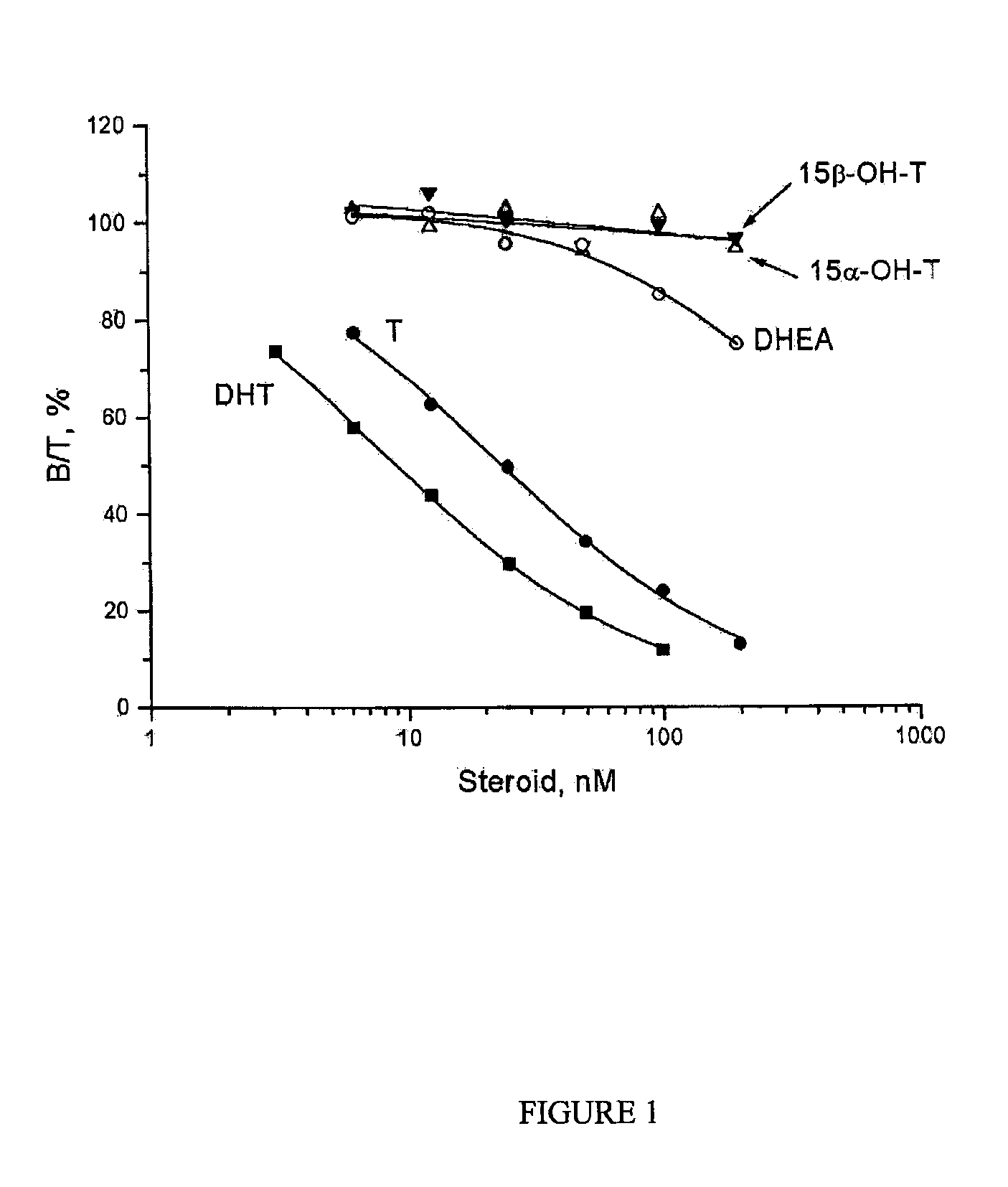Pharmaceutical application of 15- or 16-substituted testosterone analogues
a technology of testosterone analogues and drug dosage units, which is applied in the field of steroid chemistry, can solve problems such as pronounced side effects, and achieve the effects of reducing side effects, reducing side effects, and reducing side effects
- Summary
- Abstract
- Description
- Claims
- Application Information
AI Technical Summary
Benefits of technology
Problems solved by technology
Method used
Image
Examples
example 1
An established competitive steroid binding assay was used to determine the relative binding affinity of 15α-hydroxytestosterone (15α,17β-dihydroxy-4-androsten-3-one), 15β-hydroxytestosterone (15β,17β-dihydroxy-4-androsten-3-one) and 16β-hydroxytestosterone (16β,17β-dihydroxy-4-androsten-3-one) to the androgen receptor (AR). Testosterone (17β-hydroxy-4-androsten-3-one) and 5α-dihydroxytestosterone (DHT, 5α,17β-dihydroxy-androstan-3-one) served as controls in this assay.
The method employed was adapted from the scientific literature and described in detail by Chang et al (1987, J. Steroid Biochem., 27, 1-3, 123-131). Recombinant rat AR was expressed and purified from E. Coli. The in vitro assays involved the use of AR and [3H]mibolerone, at a fixed concentration of 1.5 nM, as the labeled ligand. Recombinant AR was dissolved in binding buffer (50 mM Tris-Base, pH 7.5, 0.8 mM NaCl, 10% glycerol, 2 mM dithiothreitol, 1 mg / ml BSA and 2% ethanol) and duplicate aliquots were then incubated w...
example 2
To determine the in vivo androgenic potency of 15-substituted testosterone derivatives, 15α-hydroxytestosterone (15α,17β-dihydroxy-4-androsten-3-one) and 15β-hydroxytestosterone (15β,17β-dihydroxy-4-androsten-3-one) were administered orally, once daily, to immature male Wistar rats for 5 consecutive days. Testosterone (17β-hydroxy-4-androsten-3-one) and 5α-dihydroxytestosterone (DHT, 5α,17β-dihydroxy-androstan-3-one), both administered orally, served as positive controls in this bioassay.
15α-hydroxytestosterone, 15β-hydroxytestosterone, testosterone and 5α-dihydroxytestosterone were dissolved in an aqueous suspension of 2% Tween 80, at final test concentrations of 3 mg / ml and 1 mg / ml. Groups of 5 immature male Wistar rats, weighing 50±2 grams, received either vehicle treatment or were administered 30 or 10 mg / kg / day test substance by oral gavage in a dosing volume of 10 ml per kg for 5 consecutive days. During the experiment, animals were housed in cages of 45×23×15 cm and maintaine...
example 3
An established competitive steroid-binding assay (Hammond and Lahteenmaki. 1983. Clin Chem Acta 132:101-110) was used to determine the relative binding affinity of 15α-hydroxytestosterone (15α-OH-T), 15β-hydroxytestosterone (15β-OH-T), dehydroepi-androsterone (DHEA), testosterone (T) and 5α-dihydrotestosterone (DHT) for human sex Hormone Binding Globulin (SHBG).
Human SHBG was purified from transgenic mouse serum, as described previously (Avvakumov G V et al., 2000. J Biol Chem 275: 25920-25925). The human SHBG prepared in this way was assessed to be >99% pure by polyacrylamide gel electrophoresis under denaturing conditions. Its steroid-binding characteristics are indistinguishable from SHBG in human serum (Avvakumov G V et al., 2000. J Biol Chem 275: 25920-25925). The in vitro assay involved the use of the purified human SHBG and [3H]DHT as the labeled ligand. Human SHBG was treated for 30 min at room temperature with a dextran-coated charcoal (DCC) suspension in phosphate buffered...
PUM
 Login to View More
Login to View More Abstract
Description
Claims
Application Information
 Login to View More
Login to View More - R&D
- Intellectual Property
- Life Sciences
- Materials
- Tech Scout
- Unparalleled Data Quality
- Higher Quality Content
- 60% Fewer Hallucinations
Browse by: Latest US Patents, China's latest patents, Technical Efficacy Thesaurus, Application Domain, Technology Topic, Popular Technical Reports.
© 2025 PatSnap. All rights reserved.Legal|Privacy policy|Modern Slavery Act Transparency Statement|Sitemap|About US| Contact US: help@patsnap.com

